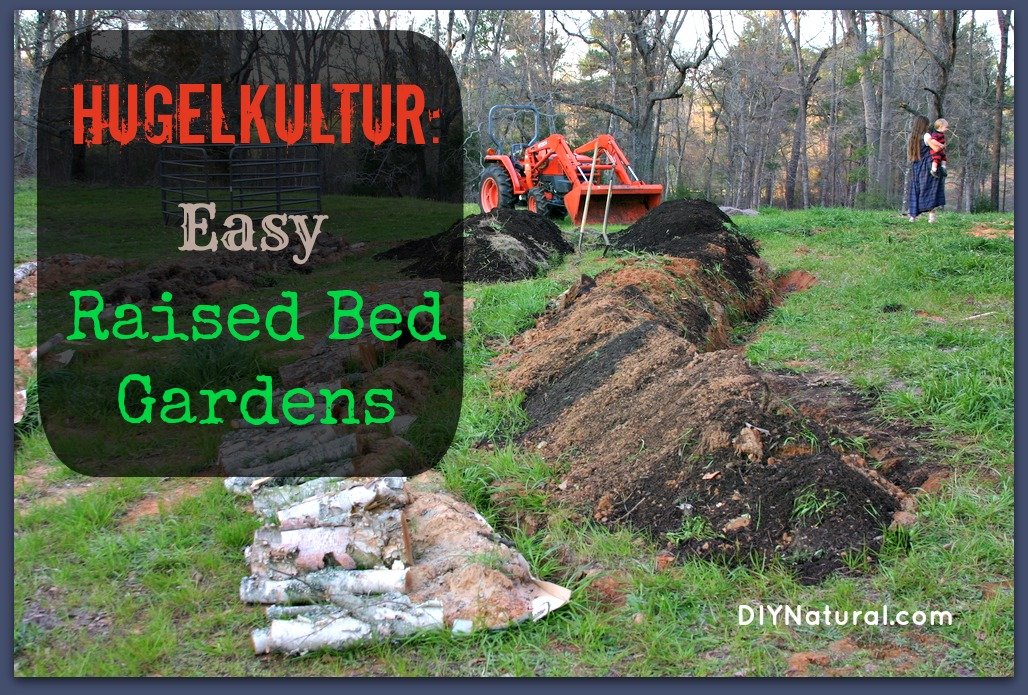

Hugelkultur is German for “Raised Garden Beds” or “Hill Culture” and it’s essentially making raised garden beds using wood logs as a base.
A few weeks ago I wrote an article on biochar, a centuries old technique for adding nutrients to the soil and retaining them. This article generated a comment that mentioned hugelkultur. What I read was intriguing, so I researched it and found that I wanted to learn more. Much more!
Hugelkultur is essentially making raised garden beds using wood logs as a base. The word hugelkultur translates to “hill culture.” You add soil to the top and leave it to do what it does naturally. The microbes in the soil start to break the wood down and add nutrients to the soil. The wood composts under the soil, retaining water and nitrogen. After the first year, it becomes self-tilling, so you only need to plant, harvest and enjoy. Sound simple? It really is.
How to build hugelkultur beds
Start with a pile of wood. Lay it out where you would like your garden bed to be. Add more wood until it is about six feet tall. You can go shorter to begin with, but taller is better since it will break down over time. Also, you can dig it into the ground to create a pit effect, but above ground is better. You can build the beds anywhere, but full sun is optimal. When you get the logs where you want, add a layer of soil to the top. This may be a good time to water the entire thing. Add fertilizer if you wish at this point. I mix my manure with soil and compost and use this to put on top.
Plants can then be planted along the sides. You may need to fertilize and water at first, but as the wood breaks down, it’ll become less and less necessary. (Click here for more images of hugelkultur beds.)
READ RELATED: Mexican Street Corn: Great Recipe for Warm Mexican Street Corn Salad!
How hugelkultur works
Over time, the wood breaks down, creating air space for microbes to colonize and nutrients to hide out in. Using biochar in addition to the soil would maximize your soil capacity. After the first year, it should break down enough that you don’t need to do anything other than plant your plants. It becomes self-tilling, making the soil more and more usable. This method lasts for years, so you don’t need to till and weed every year. The mounds do get some weeds at first, but they are easy to pull out since there is a slope on the sides.
Sustainable raised bed gardening
Hugelkultur may be a funny sounding name, but its benefits are no joke. Some benefits of hugelkultur include the following:
- After established, they require no fertilizer or irrigation.
- It works anywhere, from the rain forest to the desert.
- The raised mounds are great for gardeners with mobility issues.
- It could provide poor countries with a means to produce massive quantities of food.
- You can use twigs, branches and logs. It all becomes buried wood.
- It can be built in-ground, but above-ground is best.
- You can start small and go bigger later.
- You can stick with smaller mounds.
- It sequesters carbon in the ground, not adding to greenhouse gasses.
- Hugelkultur allows you to take advantage of downed trees.
- All of the nutrients produced are organic.
- Air pockets are produced for microbes and worms.
- Speaking of worms, vermiculture can be easily added.
- It’s self-tilling.
- It holds massive amounts of water without rotting roots. The wood acts like a sponge as it breaks down, holding lots of water.
- Fungi, such as mycorrhizae, are beneficial to the soil. Fungi colonize rapidly in decaying wood.
The right wood for hugelkultur
While almost any wood can be used, you want to stay away from cedar and walnut. They have resins and toxins that aren’t good for plant life. Cherry can be toxic to animals, so it’s not a good choice either. Locust should also be avoided because it’s very slow to break down. Some of the better woods are apple, alder, cottonwood, birch, willow and poplar. Pine is ok, but as it first breaks down, it will suck nitrogen out of the soil in large amounts. Knowing this, you can add extra nitrogen for the first few years. (Find nitrogen-rich blood meal here.) After it breaks down enough, it starts giving nitrogen back. Do a soil test occasionally so you know what the exact conditions are. (Find soil testing kits here.)
Hugelkultur is an old way of gardening, but it’s new to us here in the USA. Folks have been using this method for a long time, but the applications remain the same. It’s an easy way to create a raised bed that you’ll enjoy for years. Self maintaining and stabilizing, hugelkultur seems to be the way to go.
*******
Source: DIY Natural – Food






